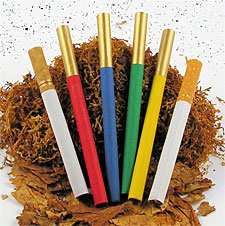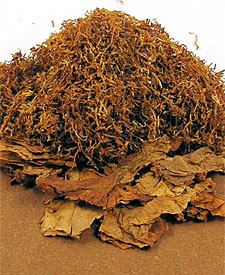A BRIEF HISTORY OF CIGARETTES
 There has never been a product that is both loved and hated as much, or by so many people, as the cigarette. There are those who exalt its pleasures while others consider it evil and crusade to eliminate its use and existence. It is not clear when the first "cigarette" was consumed, but it is reported that tobacco was smoked within the husk of a corn cob as early as 1518 in Mexico. While there are many definitions used to classify tobacco products as cigarettes, primarily for taxation purposes, we will simply define them as finely shredded tobacco which is wrapped in paper, smoked, and inhaled for consumption. Roll-Your-Own (RYO) and Make-Your-Own (MYO) cigarettes refer to tobacco which is sold "loose" for the consumer to make their own cigarettes. There has never been a product that is both loved and hated as much, or by so many people, as the cigarette. There are those who exalt its pleasures while others consider it evil and crusade to eliminate its use and existence. It is not clear when the first "cigarette" was consumed, but it is reported that tobacco was smoked within the husk of a corn cob as early as 1518 in Mexico. While there are many definitions used to classify tobacco products as cigarettes, primarily for taxation purposes, we will simply define them as finely shredded tobacco which is wrapped in paper, smoked, and inhaled for consumption. Roll-Your-Own (RYO) and Make-Your-Own (MYO) cigarettes refer to tobacco which is sold "loose" for the consumer to make their own cigarettes.
While it is impossible to date the first use or consumption of the cigarette, the industry would begin to flourish after the 1830s when Virginia varietal tobacco cultivation was expanded to the inland Piedmont region of Virginia and North Carolina. Farmers moving west during the early 1800s discovered that the sandy, grayish soil in the Piedmont region produced a thinner, less heavy leaf that was lighter in flavor than previous cultivation. More specifically, the flue-curing process that was used on these Virginia varietals yielded a tobacco that was more acidic than its predecessors or counterparts. Ultimately, the lighter flavor and aroma of the Virginia tobacco, coupled with its higher acidity made it ideal for inhalation - as the lungs absorb acidic smoke more easily than alkaline smoke. Ironically, the alkaline properties of stronger, darker tobaccos used for cigars and pipes made it impractical, if not impossible, to inhale. By 1864, a mild and light varietal of air-cured Burley, known as White Burley, was developed and was suitable for inhalation/cigarettes as well. Either through accident or coincidence these tobaccos emerged in time to help create a whole new economic and social force: the American cigarette industry.
CIGARETTES ARE DIFFERENT
By the 1800s we see a revolutionary change, with the emergence of cigarettes, in the way tobacco can be used. Until then, tobacco was either smoked in a pipe, as a cigar, or simply chewed. With regard to cigarettes, it is imperative to understand that the absorptive capacity of the lungs is hundreds of times greater than the tissue in the mouth. Thus, far more nicotine is passed into the bloodstream when smoke is inhaled. When cigarette smoke is taken into the lungs, it deposits 80% of the tars into the respiratory tract and passes 90% of the nicotine directly into the bloodstream. Within seconds of each inhalation, nicotine-sensitive receptors in the brain activate neurotransmitters which cause the release of enzymes. These enzymes quickly increase heart rate, raise blood pressure, constrict blood vessels, and produce other reactions which create a mildly narcotic effect on the user. Consequently, the lung-specific delivery method and concentration of nicotine, coupled with the instantaneous effects of inhalation, are what make cigarette smoking a potentially compulsive and/or addictive behavior. This potent, nearly instantaneous cigarette “high” is profoundly different from the experience of cigar and pipe smokers who absorb nicotine through their mouth, not the lungs. |
By the time of the Civil War, American soldiers discovered the pleasures of rolling cigarettes from bright tobaccos. This trend would give birth to the American Cigarette: a cigarette which is mostly comprised of Bright Virginia tobaccos. Another popular cigarette emerged during the 1800s from Oriental tobaccos grown in eastern Mediterranean countries: they are known as Turkish Cigarettes. While Oriental tobaccos are sun-cured and lower in nicotine content, they have a richer flavor and became popular for blending with Bright Virginia tobaccos. Consequently, during the 1800s, the two main families of cigarettes were born: American and Turkish. In addition, the blending of these different tobaccos, including Burley and Maryland, led to a variety of cigarette products designed to suit a myriad of tastes and strength preferences.
INDUSTRIALIZATION YIELDS MASS-COMSUMPTION
By the late 1800s, most consumer products in America were being produced by high volume, low-cost manufacturers. The industrial revolution was dramatically changing the pace of culture and society throughout the world. Ironically, most cigarettes were still being rolled by hand by consumers or in massive factories which employed large, dexterous labor forces. An efficient machine which could mass-produce cigarettes had yet to be invented. It was not until 1880 that a twenty-one year old inventor named James Albert Bonsack would patent the revolutionary Bonsack cigarette injecting machine. The Bonsack Machine would change the tobacco industry, and perhaps the course of human history, forever. The Bonsack machine ushered in the age of mass-produced cigarettes; which competed primarily on low prices and relied upon massive economies of scale. Ultimately, the mass-production of cigarettes led to increased consumption as well as the introduction of chemicals and additives to homogenize the tobacco and flavor. The age of hand rolling natural tobacco cigarettes for taste, flavor, and relaxation purposes was essentially over. From about 1900 on, the cigarette business became an economic and profit powerhouse around the world. |
During the first half of the twentieth century, mass-produced cigarettes became ubiquitous, cheap, and the ultimate pacifier for people coping with the challenges of the accelerating pace of life. Modernity and the cigarette were perfectly compatible. For a myriad of reasons, millions of people have sought comfort, solace, relaxation, and adrenaline from the cigarette. That people take pleasure from it is irrefutable. Through unparalleled print, radio, and television advertising, the cigarette industry sold adventure, sophistication, sexuality, and pleasure to consumers who voraciously inhaled it all. By 1950, almost half of the U.S. population smoked cigarettes, and many people believed it was a cleansing and healthy activity.c
TOBACCO vs. CIGARETTES
Today, 95% of the money generated by the tobacco industry is from cigarettes. As a result, most people associate the word tobacco with "cigarettes". When people discuss the negative health effects of "tobacco", they actually mean "cigarettes". Print publications, the media, politicians, and even the TSA agreements use the word "tobacco" when referring specifically to "cigarettes". In the public realm, there is little distinction made between different types of tobacco, consumers, or consumption patterns. "Tobacco" is a bad word in contemporary society, yet this is a misnomer. The political, social, and cultural turmoil over one product - cigarettes - has besmirched a much broader and more profound industry. |
On Saturday, January 11, 1964, the Surgeon General publicly released the report that declared cigarette smoking to be a health hazard. Within a year the Federal Trade Commission (FTC) would mandate that all cigarette packs and advertisements be clearly marked with a health warning, known as the Surgeon General’s Warning.
On November 23, 1998, after years of litigation between state courts and the cigarette industry, leading U.S. cigarette manufacturers signed an agreement with the Attorneys General of 46 states, five U.S. territories, and the District of Columbia, known as the Master Settlement Agreement, or MSA. Previous agreements were already signed with the other 4 states. Collectively, these agreements are known as the state Tobacco Settlement Agreements, or TSA. While the TSA is a large and complex contract, the major principles are:
- Fundamental changes to the way cigarettes are advertised, marketed, and sold in the United States, with particular emphasis on protecting children.
- The creation and funding of the American Legacy Foundation, which is devoted to anti-smoking education and counter-advertising to the cigarette industry.
- Perpetual payments by the companies to the states (over $200 billion by 2025).
In exchange for agreeing to the TSA provisions, the states agreed to end civil litigation aimed at recouping healthcare costs associated with cigarette smoking. The TSA does not release participating manufacturers from civil claims from individuals, classes of individuals, or the federal government. Ultimately, the TSA has fundamentally changed the social and political landscape for the cigarette industry and consumers. Today, the industry is the most highly taxed and regulated industry in America, and has the unique distinction of being the only industry legally required to fund its opposition.
Currently about 20% of Americans smoke cigarettes. In much of the developing world smoking is on the rise, partly because it is still considered emblematic of advancement, fashionable, and attractive. On the other hand, anti-smoking laws are more prevalent today than ever before. The European Union and the United States are quickly moving towards being smoke-free societies. Smoking has been banned in most public and private places throughout the U.S. Today, there is almost no place left to enjoy tobacco products. And all of this societal backlash against "smoke" is directly related to cigarettes and the health costs associated with their consumption. Of course there is also significant anger against the cigarette companies for shaping public perception to improve their own profitability.
HOMOGENIZED & RECONSTITUTED TOBACCO
During the 1930s, the cigarette industry began developing homogenized forms of tobacco which could be manipulated to deliver consistent taste and smoking qualities at an economical cost. The result of this pursuit was reconstituted tobacco sheet, or RTS. The manufacturing of RTS initiated and enabled unprecedented manipulation to the cigarette and its constituents. RTS consists of tobacco scraps as well as stems, ground up and mixed with additives, flavorings, cellulose (for adhesion), and other potential ingredients. This unnatural concoction is then formed into thin sheets and chopped up to be used as cigarette filler. Today, most cigarette manufacturers use some form RTS in their products and only one major manufacturer, Santa Fe Natural Tobacco Co., refuses to use it at all.
By the 1950s, a similar method of homogenization was developed which could be used on cigars. This tobacco-like product ushered in a new era of inexpensive, machine-made cigars.

Closeup: Reconstituted Tobacco Sheet (R.T.S.) |

Top: Shag-Cut Virginia leaf
Middle: Virginia leaf
Bottom: R.T.S. |
Tobacconist University® does not recognize reconstituted and/or homogenized tobacco as a natural, premium, or luxury product.
|
Certified R&D Tobacconists: United States |
|
|
|
|
|

